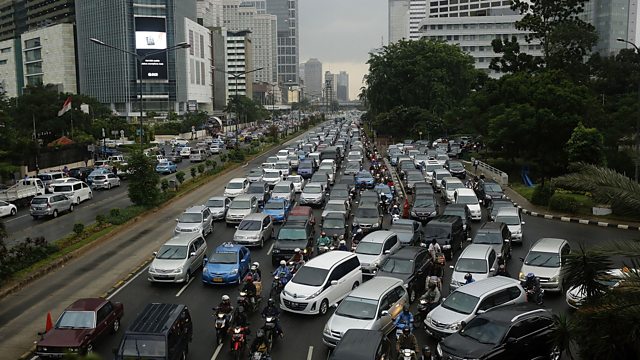Restricting Traffic in Jakarta
Measuring traffic in Jakarta, priming Indian pre-schoolers for learning maths, dinosaurs evolving into birds and the amazing technicolor nano-sponge.
Traffic in Jakarta, Indonesia, is amongst the worst in the world. With a population of over 30 million, drivers in the city experience an average of over 100 “stops and starts” per day. To mitigate against this constant gridlock, the Indonesian government implemented a high-occupancy vehicle (HOV) policy, where vehicles travelling on designated roads at peak hours were required to carry three or more people. Despite running since 1992, the government suddenly cancelled the policy in early 2016. This provided a rare opportunity to perform a live, natural experiment. By measuring the traffic flows before and after the restrictions were lifted, it was possible to gain an insight into whether HOV policies actually work.
Boosting Maths Skills
In many developing countries primary school attendance is improving. Yet, learning outcomes remain poor and children are still falling behind their western counterparts. This is particularly the case in India. One potential contributing factor is pre-school learning. A high percentage of children in India are the first generation in their families to attend school, and so it might be that parents are not equipped to teach and encourage the basic skills that form the groundwork for later, formal tuition. To investigate, psychologist Moira Dillon developed games designed to improve numerical and spatial reasoning for preschool children in Delhi. The children were then tested later on to see if the games had made a difference to how well they learnt maths at school.
Dinosaurs of China
Fossils from China are changing the image of dinosaurs. Rather than huge lizards, it seems that some dinosaurs might have more closely resembled massive chickens. Since the discovery of the transitional fossil Archeopteryx, a small dinosaur with broad wings, feathers and a long tail, we’ve known that birds and dinosaurs are close relatives. Now, incredibly well-preserved feathery fossils from the Liaoning province in North Eastern China are being shown in an exclusive exhibition at Wollaton Hall in Nottingham. These fossils provide a new insight into just how bird-like many dinosaurs would have appeared, revealing many familiar characteristics to our own modern birds.
Nanocolours
Imagine having planes and cars covered in vivid, bright colours like the exotic birds and butterflies found in hot climates. It could soon be possible with metallic nano-sponges. These tiny networks of holes and tubes soak up light, rather than water. Nano-sponges mimic nature’s network-based colour structures, such as that responsible for the beautiful blue plumage of the South American plum-throated Cotinga (bird). Unlike paint, which contains coloured pigments that absorb light of a particular wavelength, structural colours arise through light interacting with a material’s surface structure. This means that nano-sponges can be simply applied as a metal coating, to produce colours from auroral greens to velvety reds.
Picture: Jakarta Grinds To A Halt As Rush Hour Traffic Hits The Streets, © Ed Wray/Getty Images
Presenter: Roland Pease
Producer: Fiona Roberts
Last on
More episodes
Previous
Clips
-
![]()
Experimenting with traffic
Duration: 01:19
-
![]()
Incredibly preserved feathered fossils from China
Duration: 00:58
Broadcasts
- Thu 6 Jul 2017 19:32GMT���˿��� World Service except News Internet
- Fri 7 Jul 2017 02:32GMT���˿��� World Service Americas and the Caribbean
- Fri 7 Jul 2017 04:32GMT���˿��� World Service except Americas and the Caribbean, East and Southern Africa, News Internet & West and Central Africa
- Fri 7 Jul 2017 06:32GMT���˿��� World Service East and Southern Africa
- Fri 7 Jul 2017 13:32GMT���˿��� World Service Australasia
- Sun 9 Jul 2017 00:32GMT���˿��� World Service except News Internet
Podcast
-
![]()
Science In Action
The ���˿��� brings you all the week's science news.




